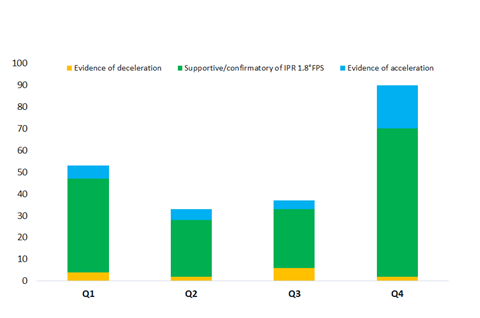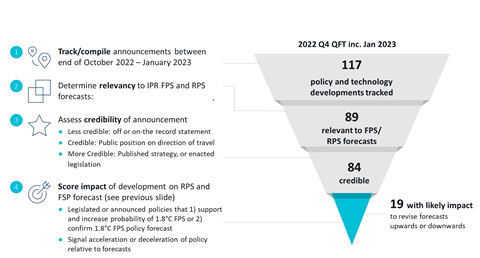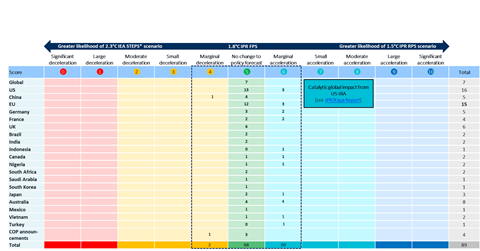This fourth QFT Update covers the period from October 2022 to December 2022.
Q4 climate and technology developments show an acceleration beyond the IPR 2021 FPS (1.8C) in key regions and sectors
-
The Quarterly Forecast Tracker monitors momentum and level of ambition on global energy and land transition policy and technology developments. These are assessed against the IPR Forecast Policy Scenario (FPS) which results in 1.8⁰C of warming and are also in the context of the 1.5⁰C Required Policy Scenario (RPS)
-
Q4 saw an increase in both the number of policy and technology announcements, and their level of ambition compared to previous QFTs
-
Following the last QFT, published pre COP27, there have been numerous significant announcements we track in this update (57 policy and 32 energy technology and land announcements relevant to the IPR 1.8 FPS)
-
A significant number of policies are scored acceleration (17):
-
The EU, US, Canada and Australia show evidence of acceleration in policy ambition across clean power, industry, transport and buildings. Policies tackling methane from oil & gas operations and agricultural sources are also beginning to emerge
-
In non-OECD countries, Just Energy Transition Partnerships in South Africa, Indonesia and Vietnam could accelerate coal generation phaseout timelines if sufficient private capital can be deployed
-
Brazil has recommitted to forestry protection and a COP 27 initiative aims to translate the Glasgow Pledge into action. These along with complementary policies from the EU (e.g., targeting forest product imports) and financial flows into nature-based solutions raise prospects for ending net deforestation by 2030, although firmer policies and commitments are still required
-
-
Of the 32 technology announcements, several hydrogen announcements suggest innovation at a greater pace than previously anticipated
-
This QFT is accompanied by a new key paper written by Kaya, “Race to the top on clean energy – the US and EU response to China’s dominance” that further explores this dynamic
-
When combined with the significance of the Inflation Reduction Act along with the increased imperative of energy security following the Ukraine war, both of which Kaya has written on extensively1, this points towards an acceleration in clean energy deployment (e.g. renewables and technologies such as heat pumps) in the medium term in Europe and China beyond our IPR forecast assumptions last updated in the October 2021 FPS
-
We continue to track the increasing importance of Just Transition concepts in international climate policy making. An accompanying assessment by LSE finds JT elements are taking on increased prominence in climate policy formulation and stronger than previously seen
A trend of acceleration in policy announcements relevant to the 1.8°C FPS forecasts is emerging
QFT 2022 announcements by quarter

Quarter 4 Assessment Process
IPR QFT assessments adopts a multi-step approach to assessing key policy and technology developments impacting the IPR 1.8C FPS and 1.5C RPS

Quarter 4 Heat Map
In Q4, we are still tracking momentum around 1.8C FPS.
-
This assessment covers the period from the beginning of October 2022 to the end of December 2022
-
The IEA’s ‘Stated Policy Scenario’ or STEPS reflects current policy settings based on a sector-by-sector assessment of the specific policies that are in place, as well as those that have been announced by governments
Q4 2022 climate announcements have reinforced the 1.8°C Forecast Policy Scenario pathway and in some instances shown evidence of acceleration

Just Transition
-
An accompanying paper by the LSE finds recent developments in international policy-making confirm that the Just Transition has rapidly moved up the global climate policy agenda, making headlines at COP27
-
The Assessment shows that Just Transition elements are stronger than previously. For example, in the US, the EPA’s rule-making process now includes strengthened requirements to consider environmental justice. In the EU, new policies are connected to the broader Green New Deal and paired with social protection measures.
-
However, many policies tracked are still high level (e.g. Just Transition partnerships). Clearer Just Transition elements are expected to emerge as we get further into the implementation phase of the transition. For example, we have seen promising follow-through actions in the South Africa Just Energy Transition Investment Plan. Partnerships in Indonesia and Vietnam are likely to follow similar pathways In many cases, Just Transition elements in recent policies are absent or could be considerably stronger. As policies shift to implementation phase, JT elements could feature more prominently.
-
Policies concerning methane emissions are on the rise. The Q4 review found that Just Transition elements and framing are relatively absent in these policies. Although distributional impacts associated with methane policies may not be as stark as in other contexts, this may nonetheless be an area to watch in coming months.
-
There continues to be significant regional variation in the incorporation of Just Transition considerations.
-
The strongest Just Transition elements continue to be observed in policies reviewed in Europe and South Africa.
-
Policies in Indonesia, Vietnam and Mexico also had strong Just Transition framings. Whilst this is a positive signal, all policies were high-level documents issued in international settings (NDCs and political statements), and we would expect further details in implementation actions.
-
High-level commitments to Just Transition continue in Australia, North America and Canada, although some remain relatively weak.
-
-
Although engagement is, on average, weak to moderate, the Just Transition has gained traction through 2022. There is cautious optimism that it will continue to become stronger over time and more Just Transition considerations will filter through policy-making processes.
Read more
IPR Special Paper: Race to the top on clean energy – the US and EU response to China’s dominance
IPR Special Assessment: Assessment of Just Transition elements in the Inevitable Policy Response (Q4 2022)
Previous quarter papers and assessments
IPR Special Paper: The US Discovers its Climate Policy: A holistic assessment and implications
IPR Special Paper: Can Lula save the Amazon? A Brazil Policy Analysis
IPR Special Paper: Ukraine War: The new geo-politics of energy and implications for climate policy
IPR Special Assessment: An assessment of Just Transition elements in the Inevitable Policy Response (Q1 and Q2 2022)
QFT in 2022
QFT #1 Report covering developments from COP26 to the end of March 2022 is available here.
QFT #2 Report covering Q2 2022 developments is available here.
QFT #3 report covering Q3 2022 developments is available here.
Each QFT release is accompanied by a Webinar discussing key findings.
Scheduling and details are posted on the PRI Events Page and IPR Social Media:
IPR Briefings
For more information on IPR, signatory briefings and presentations, please contact us at [email protected]
Downloads
IPR Q4 Quarterly Forecast Tracker
PDF, Size 1.8 mbIPR Just Transition Assessment
PDF, Size 0.92 mb












